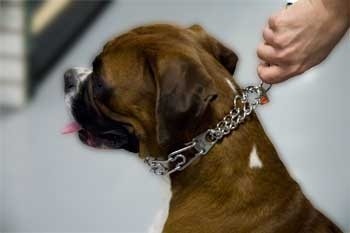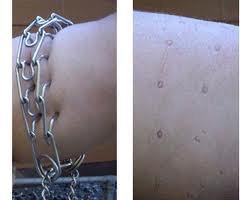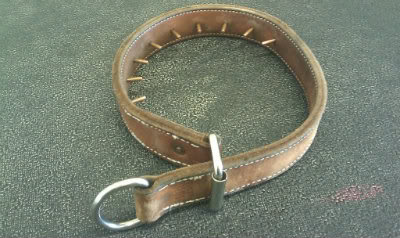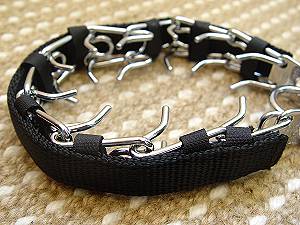Barks Blog
Why Prong Is Wrong – Physically and Psychologically
A man’s best friend deserves better
Prong collars are used to decrease behavior and involve waiting for the dog to do something wrong, like pulling, and then jerking the dog. Used “correctly” they ride high up on the neck. Starting with a play on words, replace the P in Prong with a W and, well you get the picture. The PPG BARKS from the Guild Editor has asked me to write a blog on prong collars and I graciously accepted. Apparently people want to know why prong collars are harmful (physically and psychologically). I’d like to be flip and say, well just look at them. It is so against my nature to cavort with metal, but for the sake of this blog let’s dance. For the most part, it is preaching to the choir, but let’s take a serious look at the prong collar aka pinch collar or to me a circle of blunt edged nails. Possibly, conversing to clients about these punishment tools will be easier. If you can take away any wisdom, that is the goal of this blog.
IRREVERSIBLE DAMAGE
This is the very first reason, irreversible damage. Why prong collars are harmful is best left to the experts, like the veterinarians. Dr. Peter Dobias, DVM says prong collars can cause irreversible damage. Irreversible, meaning not able to be undone or altered. Placing metal spikes to sensitive neck tissue has always baffled me, but there is more to the story.
Dr. Dobias challenges us to a little exercise.
” I invite you to do a little test. Open your hands with your thumbs touching each other. Place the thumbs at the base of the throat and with the fingers pointing back and surrounding the neck.
Now, take a deep breath, squeeze and pull back with all your force keeping your thumbs connected.
This is how many dogs feel when they are on the leash and they are pulling.” 1
Just reading that makes me panic. Yet this is what dogs are put through everyday. They have no choice, they have to keep the collar on.
This brought memories of a past client walking her six-month-old puppy with a prong collar. This pup was a rescue, reactive to other dogs. After the shock of it, “Why?”, I asked? “It makes me feel safe”, said the client. Then as a dog came into view. I slipped my hand under the prong collar sneakily and sure enough there came the forceful jerk and an “OUCH” from me. It really hurt. I wondered, but not out loud, who would be keeping the pup safe. A hand is one thing, losing a vital life force like breathing is quite another.
Wait, is that marks on skin?
Still, I didn’t blame the client, I blame commercialism, those who recommend the devices to make a quick buck or well-meaning relatives and friends because of something they saw advertised or a technique seen on a popular TV show. A magical ride to the land of fear and survival is the result for the dog. I wonder had they known what happens internally would there be reconsideration? I wondered do they know they are replacing a behavior with fear or that the behavior is still there, but the dog is too afraid of the person to follow through on the reaction. For me, this is not a relationship I want to forge with my canine companions. Preferably, teaching a dog what to do instead of the reactive behavior and reinforcing it highly just makes better sense.
The neck and cervical spine are one of the most important “energy channels” in the body. It contains the spinal cord for supply to the whole body, is where the front leg nerves originate from and it is the energy channel where the nerves controlling the internal organ function pass through. The thyroid gland that regulates the whole body metabolism is also located in the neck. If the flow of energy in the neck is interrupted or restricted, a whole array of problems may arise including lameness, skin issues, allergies, lung and heart problems, digestive issues, ear and eye conditions, thyroid gland dysfunctions and even higher cancer rates, says Dr. Peter Dobias, DVM, who apparently sees a lot of this in his clinic.2
It is like listening to one of those medication commercials where the risk list is longer than the help provided. It is simply a trade-off. It is a choice, a decision. Some are willing, ready and able to make that trade-off. I look at my dogs, my client dogs who are all challenging canines and for me, I am not willing to make that choice, or recommend it to anyone.
I keep hearing my Tellington Touch practitioner training advice, “Get the pressure off the neck.”
I don’t care if a dog is 150 pounds or 10 pounds, and whether the issue is leash manners or biting visitors. There are no dogs who need a heavier hand—there are only trainers who need more knowledge and a lighter touch. Nicole Wilde 3
PSYCHOLOGICAL AFFECTS
The psychological affects of prong collars (and other pain devices) are witnessed in submissive (subordinate) posturing and/or fear responses.4
Submissive posturing would look like this:
- Ears flat against head
- Eyes narrowed to slits or wide open with white showing (whale eye)
- Lips pulled back in what looks like a grin
Behavior witnessed would be nuzzling or licking a person or another animal. Body position is very disturbing to me and looks like this:
- A lowered to the ground posture
- Front paw raised
- Lying on back, belly up
- Possible urine leaking/dribbling and even
- Possible emptying of anal scent glands
I challenge anyone to tell me this looks like a dog who is leading a happy, fulfilled life and who wants to work (without fear) or trusts, and feels safe. Does this sound or look like a happy dog? This is not the type of dog I want to see as a trainer or as dog owner.
Further, one might see a tail tight at the base or between the legs, and vocalizations will be minimal, low, or whining and whimpering. I don’t think anyone reading is visualizing a well-adjusted dog.
Fearful body postures would look like this: (very similar to submissive postures)
- Ears laid flat back against head
- Eyes narrowed, averted and possibly rolled back into head showing whites
- Mouth, lips drawn back to expose teeth
- Tense
- Crouched low
- Shivering or trembling
- Possible secretion of anal scent glands
- Tail between legs
- Vocalizations low, whining, whimpering or growling
All similar and all pathetic. Why do people want a pathetic dog. What type of dog do you want? For me, a thinking dog, a happy participant who finds me worth listening to even if wearing no collar, or off lead running freely in the woods or on a beach is a true companion. I couldn’t imagine any of my dogs having the psychologic discord the above postures denot nor any of the challenging dogs who are my clients. Using force free training philosophies and science makes use of a prong collar a non-issue.
PRONG COLLARS START TO DECEIVE
Today prong collars take on many faces. Hiding them inside a flat collar is one of those faces.
What do you say to a client on the verge of using a prong collar – “because they feel safe”? Better yet, how have you gotten a client NOT to use a prong collar when what they’ve heard is that they should be using one?
What to say to a client
In memory of Dog Trainer Leah Roberts, she used to say:
“Explain how aggression issues can be created or exacerbated by its use and talk about alternatives. If they need more convincing, talk about the “war” going on between new, modern science-based training and traditional training, and use the comparison of how it used to be allowed that teachers rap kids’ knuckles with a ruler and think that was okay until we learned there were better, more effective ways.”
Today there are just too many alternatives that give results to continue to use archaic tools fit for the time capsule. The prong collar has some safety faults as well. It falls off, it unhooks at times and simply falls off. It uses pain. People are looking for a tool and most simply don’t know better. There are tools far superior in this day and age.
Here is a perspective from cross-over trainer Joana Watsky, Dog Trainer, Behavior Counselor NJ
“When I used to use the prong I found that dogs that had reactivity prior to the prong became more reactive.” Joana Watsky
Another quote:
Have found 2 general types of dogs who are walked in prong collars: Pit Bulls and hyper out-of-control dogs. Have found people to be exasperated with the dog and aren’t really concerned about the whole pain factor. For Pit owners, discuss the general Terrier temperament being one of tenacity and grit despite pain. So using a tool that inflicts pain to manage is ineffective because they can tolerate it especially if they can persist and get what they want. Once they try the front attachment harnesses they never go back. For the hyper out-of-control dogs, talk about comparing that dog to an ADHD child. Only so much stimulus can be applied before the dog’s head explodes. Ask them to imagine being overwhelmed at a party and in an argument with someone and then I pinch their arm (not hard) saying that adding a physical stimulus just piles more papers on the pile. For a hyper dog…it’s about calmly refocusing and redirecting them. The dog needs you to be calm so that they can focus otherwise it’s just too much to process and they inadvertently increase the dog’s frenetic behavior. I have had the most success with the ‘it’s not as effective as this because’ approach. Leanne Hugg, CPDT-KA
It isn’t the prong that “causes reactivity”, it is the “use of it = pain which creates a trigger”. I recently worked with Standard Poodle where a prong definitely caused and then increased reactivity toward other dogs. Here comes dog = pain = leash reactivity.
Another dog a German Shepherd mix came to me in a prong collar. The woman was told by her husband and an aversion academy that was necessary. The woman hadn’t touched her dog in 2 years because she was afraid. The prong usage had caused redirected/respondent aggression. The dog was so anxious he started redirecting bites on the woman. This was a case where also the husband hovered over the dog, stared, alpha rolled and on and on. One session in my studio, and not only was I touching this dog, so was the woman and the tears flowed. Today the prong is off and harness, flat collar and two points of contact are on and no one is looking back.
The wielding of the instrument is for the specific purpose of implementing force. The aversiveness of the tool, not the instrument itself, as hideous looking as it is, for instance, pens are for writing, not for poking eyes out, although they can do both. Choosing not to use pain devices allows the human to change their thinking. The nature of pain devices on dogs is not for jewelry, it is for inflicting pain when the dog does something wrong or you wouldn’t need it in the first place. The only reason to use one is because knowledge has ended and that is where aversion always begins.
Training challenging dogs on a daily basis, not once have I had to resort to or recommend a prong collar. There are so many options available today, such as harnesses, flat collars, clicker training and more. Science-based training techniques don’t require that pain be used to work through any behavior. Don’t believe those that say “some dogs need a heavier hand” or “you can’t train an aggressive dog without force” and on and on. These phrases are becoming cliche and untrue. What it does take is knowledge and not falling for deceit and claims of “quick fixes”. A dog is not a car or pipe or board, they have brains and require solid learning theory.
Watch for embellished article on prong collars in BARKS from the Guild.
References
1, 2 – Choke, Prong, and Shock Collars can irreversibly damage your dog, by Dr. Peter Dobias, DVM https://peterdobias.com/community/2011/07/dog-collars-can-cause-disease-and-possibly-lead-to-cancer/
3 – Do some dogs need a heavier hand? by Nicole WIlde
4 – Comparison of Stress and Learning Effects of Three Different Training Methods: Electronic Training Collar, Pinch Collar and Quitting Signal Tierärztliche Hochschule Hannover Institut für Tierschutz und Verhalten (Heim-, Labortiere und Pferde)https://www.retrieverpro.com/data/File/equipment/salgirliy_ws08.pdf
Resources
PPG Client handouts
https://www.petprofessionalguild.com/Resources/Documents/A%20Call%20For%20Change%20US%20Letter.pdf ACTUAL flyer to hand to client an accompaniment to this article https://www.petprofessionalguild.com/callforchangetrainingequipment
No Choke, No Prong, No Pain by PPG https://dogslifetraining.net/links-resources/
A long list of resources
Hey, have you heard the one about dog training and climate change?
The Secret to Animal Training: Behavior Science, It’s Real
Dr.Sophia Yin – Philosophy
Dr. Sophia Yin – A Better Way
Dr. Sophia Yin – Dominance
FAQ Cesar Millan, The “Dog Whisperer”
Pack of Lies
Every dog is different
Do some dogs need a heavier hand?
Dog whispering in the 21st century
Confrontational vs. Non-Confrontational
Intimidation in dog training
If you’re aggressive, you dog will be too
Dog training’s latest buzzword: “balanced”
A surprising look at “balanced” training
Dog training: the trouble with punishment
AVSAB Position Statement The Use of Punishment for Behavior Modification in Animals
Are you willing to be wrong about that?
Talk Softly and Carry a Carrot or a Big Stick?
Confrontational Training Techniques Elicit Aggression
The Dog Whisperer Controversy
Review of Dog Whisperer by Veterinary Behaviorist
Beyond Cesar Millan
Punishment affects both the dog and the owner
Welfare in Dog Training
“My way is not the only way.”
Busting the “dogs just want to please” myth







